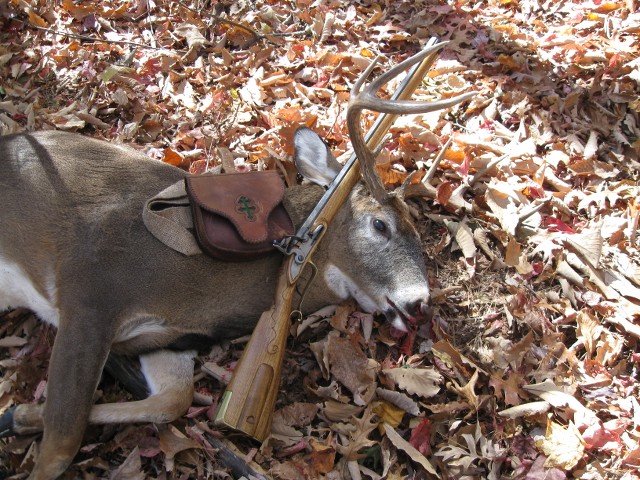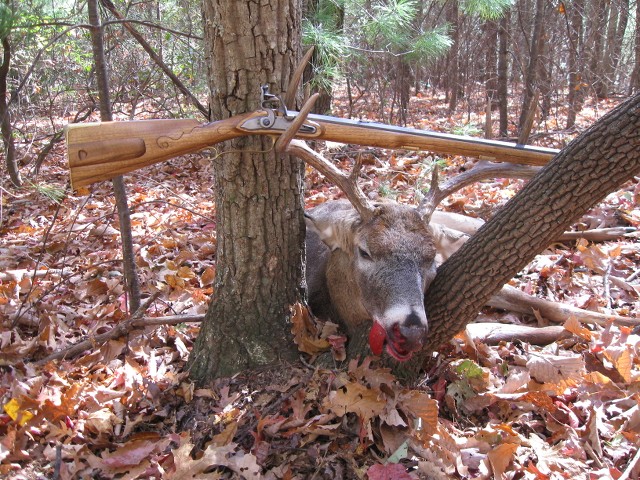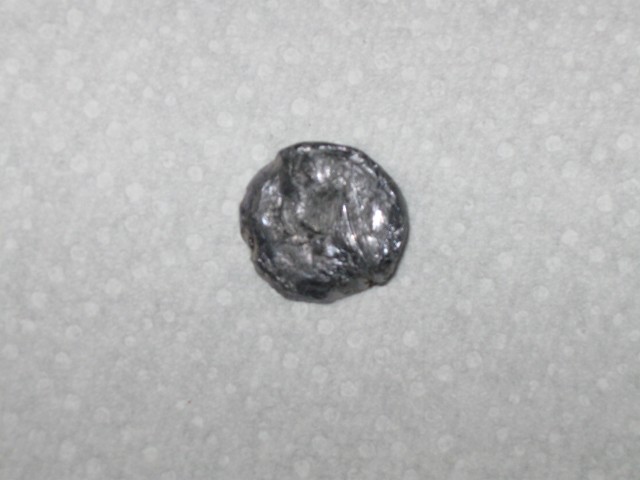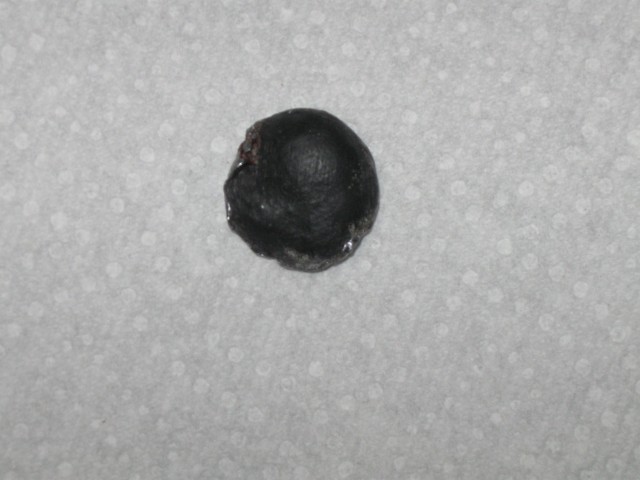Another thing that I will add to this thread on big bore rifles. At my age now, 67, while I can appreciate the finely carved & engraved longrifle, I would much rather invest my money in those tangible things that allow a shooter, centerfire, or muzzleloading, to be comfortable when shooting the rifle, comfortable when carrying the rifle, and aid him/her in shooting the rifle to his/her best ability. Simplicity rules. Nothing that doesn't contribute to the above goals gets eliminated. The following attributes are ESSENTIAL!! Light--- Short--- Ergonomic--- Friendly--- Must Have Perfect Geometry--- Sights Must Instantly Align with Shooters Eyes when Mounted--- Must Be Beautiful to Look At
My ideal rifle would be speced out like this.....
1. STOCK--- plain northern hard sugar maple for its superior strength---straight grained through the wrist---fullstock---no buttplate---no toeplate---simple round washers in lieu of a sideplate---no muzzle cap---no entry ramrod pipe---no cheekpiece---straight wrist---1.500" drop at comb---2.500" drop at heel---5.000" tall × 2.250" wide butt--- rounded heel---lightly rounded toe---1.500" wide × 1.375" tall oval wrist---12.875" length of pull---wood pores filled with black ink---stained as dark as possible with aqua fortis---dark varnish that is buffed to a matte finish--- coat of paste wax applied over the varnish.
2. BARREL---Rice Muzzleloading Barrel Company---4140 CM steel---modified Track of the Wolf Jaeger pattern---27" long---5" long fore-breech---5" long after-breech---10" long waist---5" long flared muzzle---classic Spanish proportions octagon-round barrel---40% octagon/60% round---10 409/512" = octagon = 10.798828125"---16 103/512" = round = 16.201171875"---.66 caliber---0.672" bore diameter---0.688" groove diameter---0.008" deep Forsyth-style grooves that measure 6 times wider than the lands--grooves to measure approximately 0.200" wide--- lands to measure approximately 0.040" wide---breech= 1.330" octagon---at 5"= 1.250" octagon---at 10"/waist = 0.850" round with set of double wedding bands---at 22"/end of waist = 0.850" round--- at 27"/muzzle = 0.990" round.---gain twist rifled---1 in 71" rate of twist at the breech---1 in 40" rate of twist at the muzzle.
3. BREECH PLUG---custom fabricated---0.750" long × 1.330" octagon flint breech plug with integral hook---3/4"-16 × 0.625" long thread journal---0.375" diameter × 1.0625" deep powder chamber---6.250" long beavertail tang with integral face plate measuring 1.330" octagon---face plate pierced & shaped to mate with plug's hook---tang double-bolted to long trigger bar
4. LOCK---CNC machined---Jim Kibler---round faced English flintlock-tuned by Brad Emig---two lock bolts.
5. LOCK BOLT WASHERS---plain iron round washers that are slightly larger in diameter than the heads of the lock bolts.
6. TRIGGER & TRIGGER BAR---10.750" long trigger bar with integral ears for pinning the single trigger---single trigger set for 2.5-3 pound trigger pull.
7. TRIGGERGUARD---large bow iron triggerguard that will accept a gloved finger---screwed to trigger bar with machine screws.
8. RAMOD PIPE---iron 1/2" diameter forward pipe--- double pinned to stock.
9. RAMRODS---(4) hickory ramrods 1/2" in diameter---brass tips on both ends of the rods---faces of tips concave to fit curvature of ball---tips drilled and tapped for 10-32 threads.
10. SLING SWIVELS---custom fabricated---iron 2" wide---1.500" long modified lag bolt for the rear sling swivel post stud---stock protected from rubbing action of front sling swivel by two steel tubular inserts on the left & right sides of the forearm---tubular inserts to sit slightly proud of the wood.
11. SLING---Andy's Leather---custom fabricated 2" wide black leather Rhodesian sling---hand-forged, iron, 2" wide, Conway buckle.
12. FLINTLOCK 10- in-1 TOOL---from The Lucky Bag---Gunner's Mate flint tool with 10-32 threads---custom brass adapter to go from 3/8" diameter (tool) to 1/2" diameter (ramrod).
13. FRONT SIGHT--- brass bead that tapers both towards the muzzle, and downwards towards the barrel---set in a 3/8" wide dovetail filed into the barrel's muzzle.
14. REAR SIGHT---Lowell Haarer-style---tang-mounted ghost ring rear sight---attached to the tang with 2 screws---"ear" of the sight with the aperture, to be tall enough, and thick enough to mount a Hadley Eyedisc on it---aperture drilled and tapped for 12-40 threads---Parkerized for its non-reflective properties.
15. HADLEY EYEDISC---Montana Vintage Arms---Magnum Hadley Eyedisc---1.950" in diameter with a rubber O-ring---15 apertures---0.021" diameter to 0.115" diameter---2.5 ounces---12-40 threads---Hadley Eyedisc is for the range, or piddling around, NOT for hunting.
16. TALLEY SCOPE RING BASES---integral to the barrel---machined into the top flat of the octagonal breech---2-5 each---0.100" deep---to fit any Talley Signature Series scope ring---aluminum, steel, stainless steel, or color case hardened steel---work performed by---Dove's Custom Guns---325 Ingleside Rd.---Princeton, West Virginia
[email protected]---1-304-425-2023---approximate cost, $500.00.
17. SCOPE RINGS--- Talley---Signature Series--- blued steel---matte finish---low height---Q-D lever---30mm rings---pair.
18. RIFLESCOPE---Schmidt & Bender---EXOS---1-8 × 24mm---TMR SFP CQB2 ASVII // BDC2---Posicon 1cm / 100m cw---black---illuminated CQB2 reticle.
19. BARREL KEY WEDGES---two iron keys with matching underlugs that are relieved to allow for seasonal stock movement---no escutcheon plates.
The only thing I am waffling about is adding an entry ramrod pipe.
The above, while a lot of typing, sets out what I feel would be a muzzleloading rifle capable of taking any game species in North America. Even the animals that will kill you right back, providing one has a back-up, big bore, modern rifle in the hands of an experienced guide.
This would be as close as I think one can realistically get to Col. Jeff Cooper's Scout Rifle, in a flintlock muzzleloader. It would be just over the 1 meter length requirements of the Scout Rifle. By machining the Talley dovetails just slightly in an offset to the left, clearance for the ocular bell of a modern riflescope with a 30mm tube should be easily achieved. That means that someone such as myself with terrible eyesight, can see to hunt ethically at distances over 15 yards. Which is about how far I trust myself now with open sights on a barrel.














